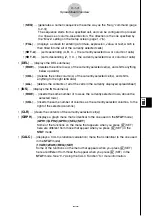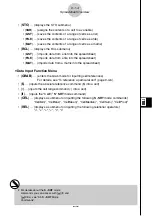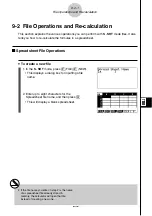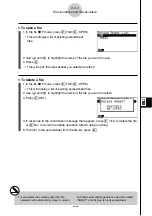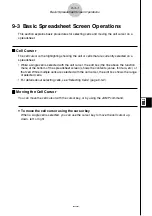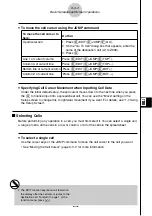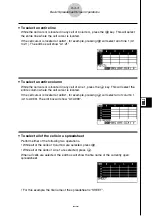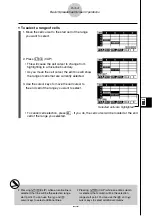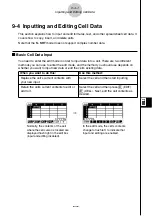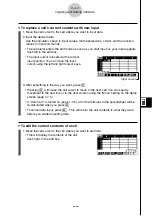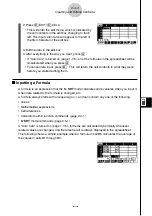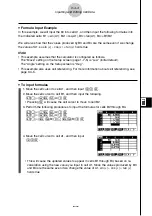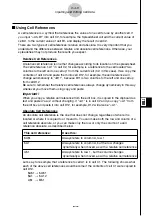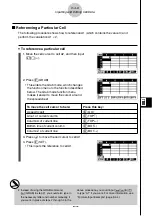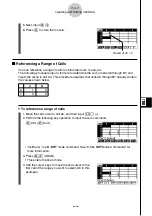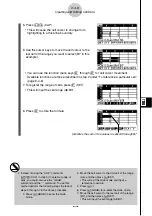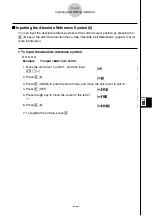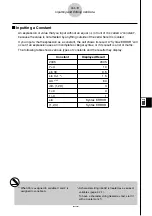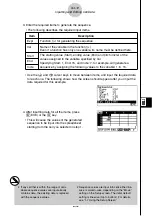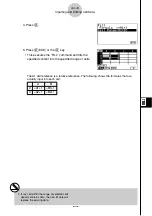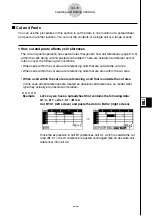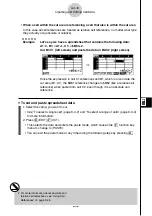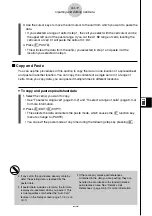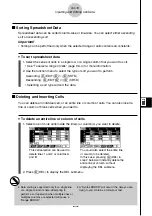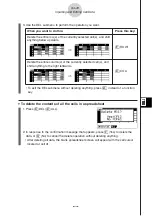
20050401
9-4-5
Inputting and Editing Cell Data
k
k
k
k
k
Using Cell References
A cell reference is a symbol that references the value of one cell for use by another cell. If
you input “=A1+B1” into cell C2, for example, the Spreadsheet will add the current value of
cell A1 to the current value of cell B1, and display the result in cell C2.
There are two types of cell references: relative and absolute. It is very important that you
understand the difference between relative and absolute cell references. Otherwise, your
spreadsheet may not produce the results you expect.
Relative Cell References
A relative cell reference is one that changes according to its location on the spreadsheet.
The cell reference “=A1” in cell C2, for example, is a reference to the cell located “two
columns to the left and one cell up” from the current cell (C2, in this case). If we copy the
contents of cell C2 and paste them into cell D12, for example, the cell reference will
change automatically to “=B11”, because B11 is two columns to the left and one cell up
from cell D12.
Be sure to remember that relative cell references always change dynamically in this way
whenever you move them using copy and paste.
Important!
When you copy a relative cell reference from the edit box, it is copied to the clipboard as
text and pasted “as-is” without changing. If “=A1” is in cell C2 and you copy “=A1” from
the edit box and paste it into cell D12, for example, D12 will also be “=A1”.
Absolute Cell References
An absolute cell reference is the one that does not change, regardless of where it is
located or where it is copied to or moved to. You can make both the row and column of a
cell reference absolute, or you can make only the row or only the column of a cell
reference absolute, as described below.
This cell reference:
Does this:
$A$1
Always refers to column A, row 1
$A1
Always refers to column A, but the row changes
dynamically when moved, as with a relative cell reference
A$1
Always refers to row 1, but the column changes
dynamically when moved, as with a relative cell reference
Let’s say, for example, that a reference to cell A1 is in cell C1. The following shows what
each of the above cell references would become if the contents of cell C1 were copied to
cell D12.
$A$1
→
$A$1
$A1
→
$A12
A$1
→
B$1
Summary of Contents for fx-9860G AU PLUS
Page 1: ...fx 9860G AU User s Guide E http edu casio com ...
Page 2: ...Important Please keep your manual and all information handy for future reference ...
Page 27: ...20050401 1 1 Keys 1 1 1 Keys ...
Page 335: ...20050401 u u u u u Input Example u u u u u Results 6 5 25 Tests ...
Page 361: ...20050401 Calculation Result Output Example p F distribution probability 6 7 15 Distribution ...
Page 435: ...20050401 8 8 2 Program Library egcw w ww w ...
Page 437: ...20050401 8 8 4 Program Library Example 1 Example 2 fw baw bf w fw baw ca w ...
Page 439: ...20050401 8 8 6 Program Library wba wb w w d ...
Page 441: ...20050401 8 8 8 Program Library dw fcde wfcde wfcde fcde w daw w 20070101 ...
Page 443: ...20050401 8 8 10 Program Library b awaw bwaw aw x d w ...
Page 590: ...CASIO COMPUTER CO LTD 6 2 Hon machi 1 chome Shibuya ku Tokyo 151 8543 Japan SA0701 E ...


